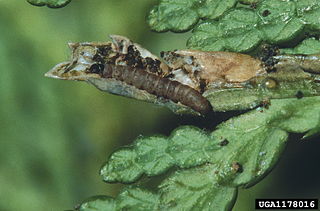| Chlamydastis curviliniella | |
|---|---|
| Scientific classification | |
| Kingdom: | |
| Phylum: | |
| Class: | |
| Order: | |
| Family: | |
| Genus: | |
| Species: | C. curviliniella |
| Binomial name | |
| Chlamydastis curviliniella (Busck, 1914) | |
| Synonyms | |
| |
Chlamydastis curviliniella is a moth in the family Depressariidae. It was described by August Busck in 1914. It is found in Panama. [1]

Moths comprise a group of insects related to butterflies, belonging to the order Lepidoptera. Most lepidopterans are moths, and there are thought to be approximately 160,000 species of moth, many of which have yet to be described. Most species of moth are nocturnal, but there are also crepuscular and diurnal species.

Depressariidae is a family of moths. It has formerly been treated as a subfamily of Gelechiidae, but is now recognised as a separate family, comprising about 2300 species worldwide.
August Busck was a Danish entomologist who became an American citizen. Busck was an employee of the Bureau of Entomology within USDA. He is best known for his work with microlepidoptera, of which he described over 600 species. His collections of Lepidoptera from North America and the Panama Canal Zone are held by the National Museum of Natural History in Washington, D.C.
The wingspan is 15–17 mm. The forewings are white faintly mixed with ochreous scales and with black markings. From near the base of the costa runs a thin black line obliquely downward and outward to the middle of the cell and then to the end of the cell, where it curves upward and inward forming an elongated question mark. At the end of the cell this black line is edged by yellow scales and on the middle of the costa is a small, black, outwardly directed spur and at apical third is a similar, inwardly directed black spur. Parallel with the terminal edge at the apical fourth is a faint row of yellowish scales, and in fresh specimens the wing is sparsely sprinkled with black scales. The hindwings are light fuscous. [2]

The wingspan of a bird or an airplane is the distance from one wingtip to the other wingtip. For example, the Boeing 777-200 has a wingspan of 60.93 metres, and a wandering albatross caught in 1965 had a wingspan of 3.63 metres, the official record for a living bird. The term wingspan, more technically extent, is also used for other winged animals such as pterosaurs, bats, insects, etc., and other fixed-wing aircraft such as ornithopters. In humans, the term wingspan also refers to the arm span, which is distance between the length from one end of an individual's arms to the other when raised parallel to the ground at shoulder height at a 90º angle. Former professional basketball player Manute Bol stands at 7 ft 7 in (2.31 m) and owns one of the largest wingspans at 8 ft 6 in (2.59 m).



